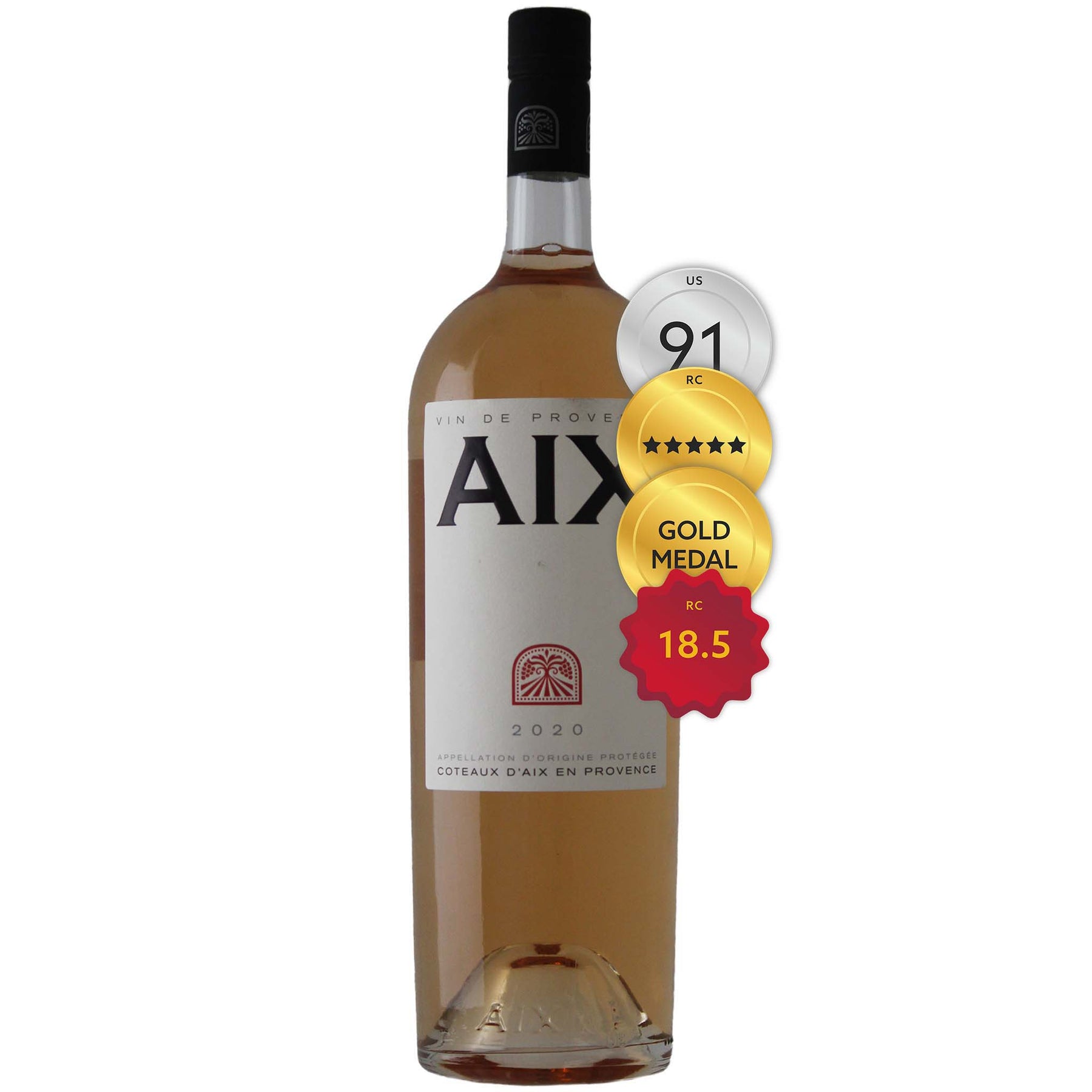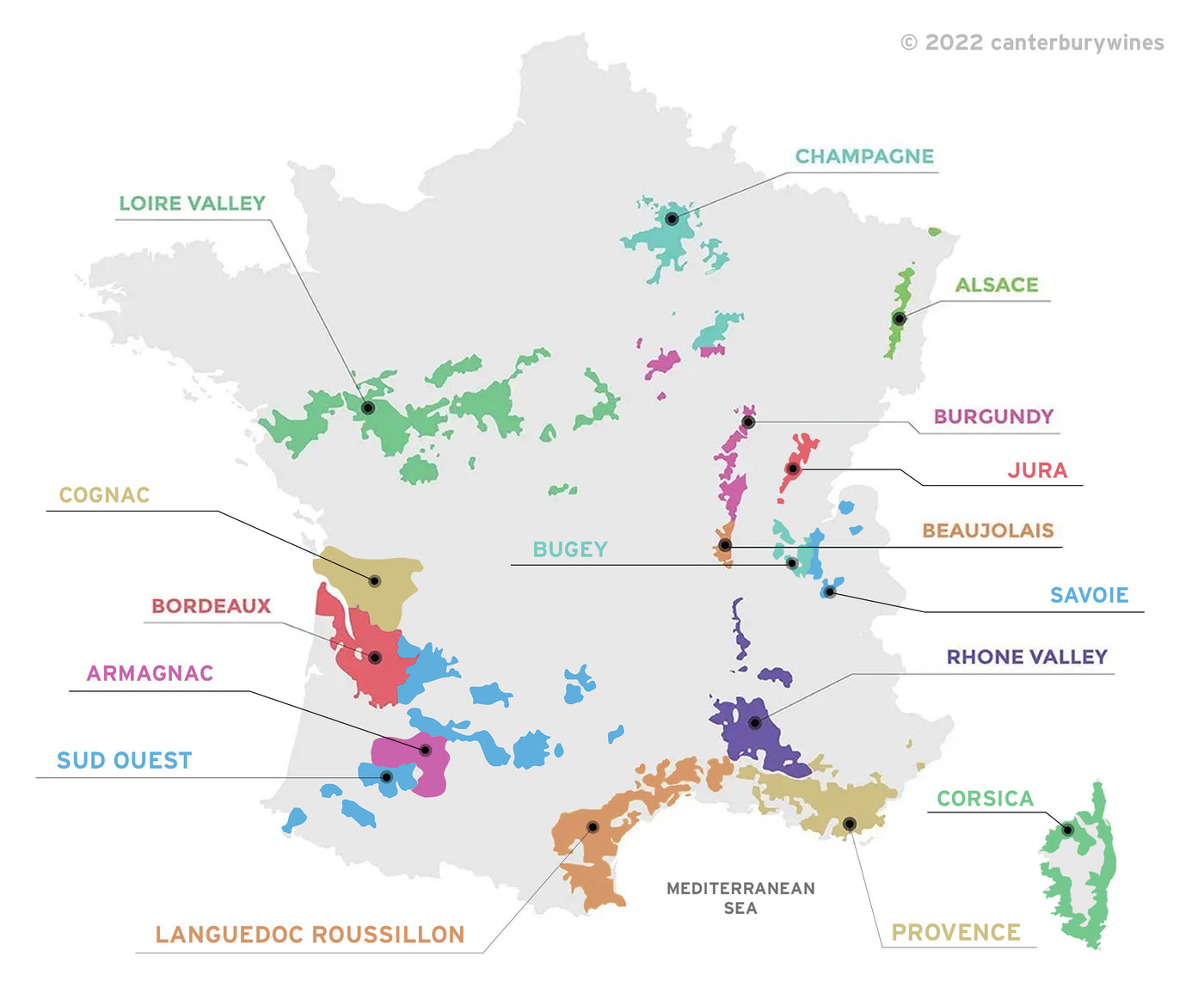

Maison Saint Aix Coteaux d'Aix en Provence AIX Rosé 2020 (1500ml)
Style: Rosé
Varieties: Grenache (60%), Syrah (20%), Cinsault (20%)
Closure: Screwcap
Maison Saint Aix Coteaux d'Aix en Provence AIX Rosé 2020 (1500ml)
Warehouse
34 Redland Drive
Vermont VIC 3133
Australia
Producer: Maison Saint Aix
Country: France
Region: Provence
Vintage: 2020
Critic Score: 18.5/20 and 91
Alcohol: 13.0%
Size: 1500 ml
Drink by: 2030
Maison Saint Aix only has one wine and one brand: AIX Rosé. It is one of the largest domaines in Provence and is situated in the Coteaux d'Aix-en-Provence appellation (one of nine appellations or sub-regions in Provence). The 75 hectare vineyard is situated 420m above sea-level and faces south-west, which allows it to receive around 300 days of sunshine and provides ideal growing conditions for Rosé. Farmed organically, the AIX Rose is made from the top blend of Maison Saint Aix. AIX was awarded the gold medal for the most celebrated rosé in the World at 'Mondial du rosé 2016' in Cannes.
The 2020 AIX Rose is made from Grenache (60%), Syrah (20%) and Cinsault (20%).
"Pastel pink colour. Pear drop on the nose and sweet cherry, strawberry. Smooth and soft attack, a mild freshness on the palate with lots of juiciness in the background and an elegant, delicate acidity. Great aperitif, but also a good companion to lighter summer dishes." Dr Ulrich Sautter
"Pale salmon pink hue. Classic Provence nose with floral notes, added peach and summer field berries with a seasoning of spice….Wow. Seriously impressive, concentrated palate with a core of white stone fruits and tropical fruits that gives the wine backbone. This is beautifully integrated with uplifting acidity and oyster shell minerality. Silky texture that flows across the palate. Serious complexity and power yet still graceful with a long distance finish, added spice and white peaches." Maison Saint Aix
Expert reviews
"Bright, pale peach-pink, even colour throughout. The nose is gently full and elegant; aromas of subtle strawberries, peaches, citrus interweave white spice and floral fragrance. Medium-bodied, a textural palate with fine-phenolics, displaying aromas of strawberries, peaches, citrus and zest melded with subtle white flowers and spices. The wine is clean and refreshing with a chalky texture; acidity drives to a dry, elegant finish. This is an elegantly classic Provence Ros? as one would expect, dry and refreshing with subtle finesse. Match with cold-smoked salmon and as an aperitif over the next 2-3 years." Raymond Chan - 18.5/20 points ★★★★★
"Pale salmon-pink. Floral nose backed by sweet spices and fruits in syrup (peach, wild strawberry). Gratifying palate with crisp freshness and fleshy fruit followed by a spicy finish. A supple, energetic and very thirst-quenching style for a festive tapas evening." International Wine Challenge 2021, Gilbert & Gaillard - Gold Medal
"Pastel pink colour. Pear drop on the nose and sweet cherry, strawberry. Smooth and soft attack, a mild freshness on the palate with lots of juiciness in the background and an elegant, delicate acidity. Great aperitif, but also a good companion to lighter summer dishes." Dr Ulrich Sautter, Falstaff International - 91 points
Awards
Gold Medal - International Wine Challenge 2021, Gilbert & Gaillard
Provence region

Provence, in the South East of France, is the rosé capital of the world. The region sits along the Mediterranean coast of France, bordered by the Rhone River to the west and the Côte d'Azur on the east. Physically, it's only about 150 miles long and 100 miles North to South, but its impact is profound.
Wine has been made here for over 2600 years, making Provence the oldest wine-producing region of France. It is also the only place to focus on Rosé - 88% of Provence wine production is dedicated to rosé! With mineral rich soils, 300 days of sun a year and the cooling Mistral winds, the Provence offers the ideal growing conditions to grow Rosé. Rosé from here is pale pink, dry, refreshing and savoury - very different to their Australian counterparts. The main grape varieties used in Rosé are Grenache, Syrah, Cinsualt and Mourvedre.
The Provence wine region is comprised of 9 main sub-regions or appellations (AOC -Appellation de'Origin Contrôlée). These appellations are shown in the map below.
The largest appellation is Côtes de Provence, which accounts for around 75% of the total production of the Provence region (of which 90% is Rosé). Second in size is Coteaux d'Aix en Provence, where Rosé is also king, which is heavily influenced by the Mistral winds. The most prestigious appellation is the much smaller Bandol. The vines in Bandol are planted on silicon and limestone soils, which together with the warm, coastal climate is very suitable for the late ripening of the Mourvèdre grape. Wines coming out of Bandol must contain more than 50% Mourvèdre in the blend whether they are Rosés or reds. Reds from Bandol are just as noteworthy as their Rosé counterparts.

The appellations of the Provence Wine Region
About the winery

Maison Saint Aix is a 140-year-old winery situated 25 kilometers outside of Aix-en-Provence. From humble beginnings in 1880 as a truffle orchard, it was converted over to vines in the early 1900s. Former advertising executive Eric Kurver and his wife purchased the winery in 2009 and renamed it after the nearby town.
Maison Saint Aix, with its 75 hectares of vineyards, is one of the largest domaines in the Coteaux d'Aix-en-Provence appellation. At 420m above sea level, it's also one of the highest. The vineyard has a south-west aspect, which allows it to receive around 300 days of sunshine. Farmed organically, the AIX Rosé is made from the top blend of grapes at Maison Saint Aix.
Maison Saint Aix only has one wine and one brand: AIX Rosé. The ethos that underpins the complex production of the wine is simply to make the very best rosé each year. As Eric Kurver points out, "My goal was to produce a thoroughly enjoyable wine, but also one that was complex and exclusive enough to win gold medals and receive excellent reviews around the world." To achieve this, the domaine has a state-of-the-art winery dedicated solely to the production of the finest rosé. Keeping oxygen at bay is also key in the fresh, mineral style that the AIX Rosé is known for.
"The domaine's 50-60 year old Grenache vines ensure highest quality 'jus', while the fruit from the younger vines brings freshness. To maintain the harmony of the land, we run a busy replanting schedule - replacing up 4 hectares a year with new vines.
Thanks to our elevation, we enjoy cooler nights and a greater Mistral effect, drying the vines on dewy mornings - making the fruit even better. In early-September, the grapes are harvested before sunrise to ensure optimal freshness of the grapes, the conservation of the most delicate aromas and a reduced risk of oxidation. This is how we achieve AIX's recognizable color, delicate aromas, gentle acidity and great length." Maison Saint Aix

France
There are 16 major French wine regions, each known for their own unique grape varieties, terroir and wines. They are Alsace, Armagnac, Beaujolais, Bordeaux, Bugey, Burgundy, Champagne, Cognac, Corsica, Jura, Languedoc- Roussillon, Loire Valley, Provence, Savoie, South-West and the Rhône Valley.
The largest region is Languedoc- Roussillon, the oldest is Provence, the most influential and famous are Bordeaux, Burgundy, Champagne, Loire Valley and the Rhône Valley.
French wine is labelled by wine region or appellation rather than by grape variety (except in Alsace). In order to guarantee the quality and provenance of French wines, the French government established the Appellation d'origine contrôlée (AOC) system. Under this system the wine label indicates the geographical origin, quality and, generally, the style of a wine. Many regions are home to multiple appellations; for example, the prestigious Bordeaux region in the southwest of France has over 60 growing appellations.

